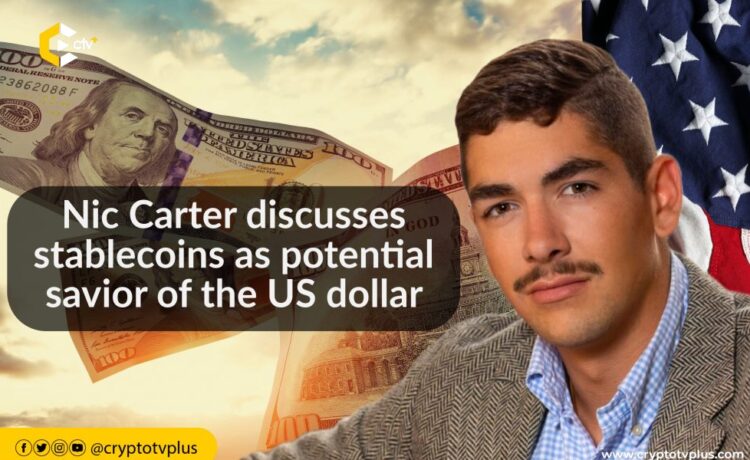At Messari’s Mainnet 2023 event, an insightful discussion took place. Nic Carter, the co-founder of Castle Island Ventures, explored the significant influence of stablecoins on the current condition of the US economy, especially regarding debt management and strengthening the nation’s global position.
Amidst this discourse, an essential decision loomed over U.S. policymakers: should they strive to prolong the supremacy of the dollar in the realm of tokenized assets, or should they relinquish ground to trailblazers of Central Bank Digital Currency (CBDC), such as China?
Stablecoins, a form of cryptocurrency, aim to offer price stability by being backed by various assets like fiat currencies, commodities, or financial instruments. Unlike the volatility often associated with cryptocurrencies like Bitcoin, stablecoins strive to present a reliable means of exchange and store of value.
Stablecoins come in different types: fiat-backed, algorithmic, crypto-backed, and commodity-backed. The most popular type is fiat-backed, pegged to a currency like the US dollar. Stablecoins have various uses, such as trading, lending, and payments.
They are programmable and work with blockchain-based applications and smart contracts. Their stability and predictability make them appealing for value storage and regular transactions. However, drawbacks include insufficient reserves and regulatory scrutiny.
Castle Island Ventures is an early-stage venture capital firm in Massachusetts. They focus on public blockchains and crypto assets, investing in infrastructure and application companies that enable transformative protocols for serving the next billion users. Established in 2018, Castle Island Ventures believes permissionless blockchains can reshape market structures and create new industries.
Debt, treasuries, and stablecoins
According to Nic, the United States is facing a challenge in selling its debts. There is indication that the government’s extensive borrowing plans have contributed to this situation. The quantity of US Treasury bonds in circulation has increased significantly in recent years, aligning with the national debt.
As a result, there is now an oversupply of US debt, leading to limited interest in Treasury bonds. Furthermore, major foreign buyers of US Treasury debt, like Japan and China, have reduced their purchases or become net sellers. Even the Federal Reserve, which holds the largest amount of US debt, has ceased buying Treasury securities and has sold a considerable portion of US debt. Nic believes that this could potentially create financial burdens for the US government.
On the flip side, it is worth noting the surprising role of stablecoins as a rapidly expanding buyer of U.S. treasuries. This observation was supported by data indicating that if stablecoins were considered a sovereign nation, they would be ranked as the 16th largest holders of U.S. debt.
This means that stablecoins, with a combined holding of approximately $120 billion in U.S. treasuries, have surpassed the holdings of certain countries. This marks a significant development in the financial landscape.
Offshore Expansion and Regulatory Challenges
Moreover, Nic revealed that stablecoins, exemplified by projects like Tether, are increasingly finding a home in offshore jurisdictions such as Bermuda, BVI, Germany, Singapore, and Hong Kong. In these locations, they receive regulatory support.
Unlike these favorable conditions abroad, the United States lacks a defined regulatory framework for guiding the use of stablecoins, particularly when it comes to their interest-bearing features. This poses a significant challenge for U.S. regulators.
Nic also pointed out that over the past year, the regulatory obstacles faced by stablecoins within the U.S. have significantly decreased. From rejected applications to a lack of encouragement from major financial regulators, the U.S. has maintained a cautious and restrictive approach toward stablecoin initiatives.
According to him, the crucial question is whether the U.S. will choose an onshore or offshore approach when it comes to stablecoins. He emphasized that the stance of Washington on stablecoins will be significant, given the increasing demand for them in the market.
The U.S. has two options: either embrace onshore regulation to gain control and influence, or watch as stablecoins expand offshore, potentially losing regulatory power and influence in this rapidly evolving financial landscape.
Conclusion: a Washington decision
According to Nick, the future of stablecoins in the U.S. hinges on policymakers. It’s not a question of if stablecoins will thrive, but rather the specific regulations and jurisdictions they will be subject to.
This crucial determination will greatly affect the U.S.’s capacity to allure fresh investors for its debt, wield financial authority, and assert control over the global capital markets via stablecoins. The onus is now on Washington to take charge.
Read also; Calimero Network’s CEO discusses community shard for data privacy in Web3

